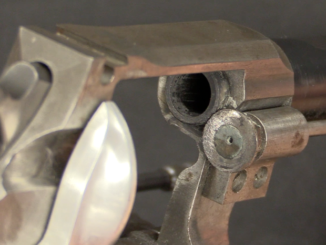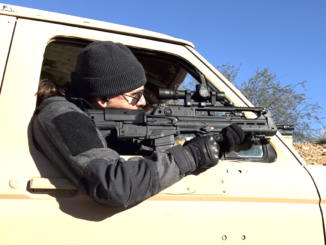Bruce Canfield’s newly released book, “U.S. Small Arms of World War II”, is a book that attempts to cover a huge amount of material from bayonets to mortars and recoilless rifles. Where most books of this type end up providing only a rather shallow view of a large number of subjects, what Canfield has done here is simply ignore the conventional wisdom about how long a book should be. Want to add more content? Just add more pages! The result is a huge 864-page tome that covers a large numbers of small arms in significant detail. This is not a true collectors guide (note that Canfield’s previous book – a true collector’s guide – was equally long and covered only the M1 Garand), but it is the most comprehensive and useful overview of this scale that I have found.
In addition to all the typical weapons you would expect to find, this work covers a great many uncommon and rare guns, including prototypes never fielded. This includes guns like the Winchester Automatic Rifle, the M2 Submachine Gun, the Johnson M1944 LMG, and so on. Many arms that made it into limited service – like the Boys antitank rifle or 2″ Victory Model revolver – are also covered. On top of that, the scope extends to several families of weapons generally not covered at all – field and specialty knives, bazookas, mortars, flamethrowers, and both rifle and hand grenades.
Perhaps my favorite aspect of the book is the extensive referencing of firsthand field accounts of weapon performance and use. How did troops really feel about their various weapons? No better way to find out than to ask them, and Canfield gives these opinions much more space in this book than most authors. I generally don’t looks for wide-coverage books like this one for my own library, but the sheer amount of context and information makes this one an exception that I am happy to have and will often reference.
“U.S. Small Arms of World War II” is printed by Mowbray and available direct from them for $95.99 plus shipping. Or via Amazon:




Does the book also cover the interwar period for things developed that could of been used in ww2, or just things invented and or used from 1941 to the end of the war? Sorry if this was answered in the video, I have limited data at work.
I think I have a copy of that earlier book if you’d like to compare them.
Research time, I saw you flip past a couple of side by side shotguns, have to wonder what those were for.
Almost certainly for training aerial gunners. Skeet shooting skills carried over to being a turret or waist gunner with surprising facility.
Hit post way too soon… Meant to mention that an old family acquaintance was a local champion skeet shooter that got pulled out of the training pipeline, made an NCO instructor, and then spent the entire war shooting skeet and training gunners with the skills. He was always aggravated that he had never gotten out of the US during the war, and pissed at the Army because of it. I guess he’d been slated for 10th Mountain and someone that knew about all his skeet trophies pulled strings to get him for some obscure gunnery base in the Southwest where the nearest sign of civilization required a train to get to…
Actor Robert Stack was another able skeet shooter who “ended up” training aerial gunners.
A book review on a Thursday?? What manner of sorcery is this????!!!
Still going through my copy that arrived yesterday. I appreciate the scope of the book but can’t help notice some omissions such as High Standard training pistols. Most egregious to my eye, however, was the photo of the CPO handling an M1 carbine on page 331, who looks ready to explain to Mr. Canfield that he is anything BUT a US Navy officer, and in no uncertain detail.
I ordered this book the day Ian published this review. It arrived October 3rd, and I’m already halfway though it. It is excellent. I thought I had learned a lot from my father and maternal grandfather, who were both career soldiers, and from my own 50 years of study and collecting, but this book describes a number of systems of which I had never heard.
Exceptional review, Ian. We currently offer this book on our website, abramsantiques.com, along with hundreds of other militaria and firearms reference books.
I like pintels and trunnions, so this is for me.
If we compare the weapons of the Second World War and the weapons that are now being produced, we can say that the difference is indescribable. I want to read this book, I just asked for dissertation help, I used https://uk.edubirdie.com/dissertation-help for that. Now I have more time. I think in the near future I will download the book into an e-book.
Rdgunbooks.com